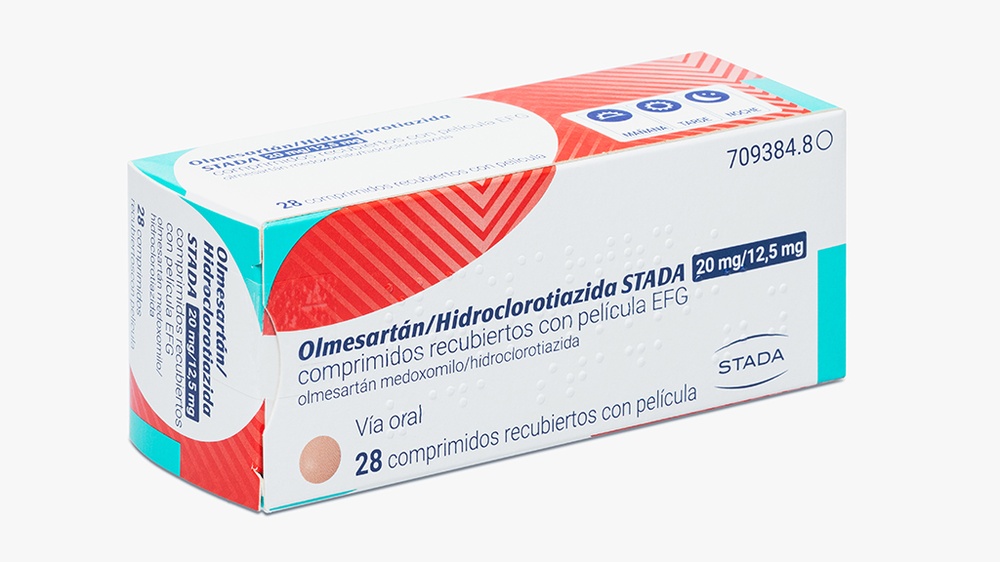

OLMESARTAN/HIDROCLOROTIAZIDA STADA 20 mg/12,5 mg COMPRIMIDOS REVESTIDOS POR PELÍCULA

Pergunte a um médico sobre a prescrição de OLMESARTAN/HIDROCLOROTIAZIDA STADA 20 mg/12,5 mg COMPRIMIDOS REVESTIDOS POR PELÍCULA

Como usar OLMESARTAN/HIDROCLOROTIAZIDA STADA 20 mg/12,5 mg COMPRIMIDOS REVESTIDOS POR PELÍCULA
Introdução
Prospecto: informação para o paciente
Olmesartano/Hidroclorotiazida Stada 20 mg/12,5 mg comprimidos revestidos com película EFG
olmesartano medoxomilo / hidroclorotiazida
Leia todo o prospecto detenidamente antes de começar a tomar este medicamento, porque contém informações importantes para si.
- Conserva este prospecto, porque pode ter que voltar a lê-lo.
- Se tiver alguma dúvida, consulte o seu médico ou farmacêutico.
- Este medicamento foi-lhe prescrito apenas para si, e não deve dá-lo a outras pessoas, mesmo que tenham os mesmos sintomas que si, porque pode prejudicá-las.
- Se experimentar efeitos adversos, consulte o seu médico ou farmacêutico, mesmo que se trate de efeitos adversos que não aparecem neste prospecto. Ver seção 4.
Conteúdo do prospecto
- O que é Olmesartano/Hidroclorotiazida Stada e para que é utilizado
- O que precisa saber antes de começar a tomar Olmesartano/Hidroclorotiazida Stada
- Como tomar Olmesartano/Hidroclorotiazida Stada
- Posíveis efeitos adversos
- Conservação de Olmesartano/Hidroclorotiazida Stada
- Conteúdo do envase e informações adicionais
1. O que é Olmesartano/Hidroclorotiazida Stada e para que é utilizado
Olmesartano/Hidroclorotiazida Stada contém dois princípios ativos, olmesartano medoxomilo e hidroclorotiazida, que são utilizados no tratamento da pressão arterial alta (hipertensão):
- Olmesartano medoxomilo pertence a um grupo de medicamentos chamados antagonistas dos receptores da angiotensina II. Diminui a pressão arterial relaxando os vasos sanguíneos.
- Hidroclorotiazida pertence a um grupo de medicamentos chamados diuréticos tiazídicos. Diminui a pressão arterial contribuindo para a eliminação do excesso de líquidos, aumentando a produção de urina pelos rins.
Apenas lhe será prescrito olmesartano/hidroclorotiazida se o tratamento com olmesartano medoxomilo sozinho não tiver controlado adequadamente a sua pressão arterial. A administração conjunta das duas substâncias ativas em olmesartano/hidroclorotiazida contribui para reduzir a pressão arterial mais do que se cada uma das substâncias fosse administrada sozinha.
Pode ser que já esteja a tomar medicamentos para tratar a pressão arterial alta, mas o seu médico pode achar necessário que tome olmesartano/hidroclorotiazida para baixá-la mais.
A pressão arterial alta pode ser controlada com medicamentos como olmesartano/hidroclorotiazida comprimidos. Provavelmente, o seu médico também lhe recomendou que faça alguns cambios no seu estilo de vida para ajudar a baixar a pressão arterial (p. ex., perder peso, deixar de fumar, reduzir o consumo de álcool e reduzir a quantidade de sal na sua dieta). O seu médico também lhe pode ter recomendado que faça exercício de forma regular, como caminhar ou nadar. É importante seguir o conselho do seu médico.
2. O que precisa saber antes de começar a tomar Olmesartano/Hidroclorotiazida Stada
NÃO tome Olmesartano/Hidroclorotiazida Stada:
- Se é alérgico a olmesartano medoxomilo ou a hidroclorotiazida, ou a algum dos outros componentes deste medicamento (incluídos na seção 6) ou a substâncias semelhantes a hidroclorotiazida (sulfonamidas).
- Se está grávida de mais de 3 meses (também é melhor evitar olmesartano/hidroclorotiazida no início da gravidez – ver seção Gravidez).
- Se tem problemas renais graves.
- Se tem diabetes ou insuficiência renal e está a ser tratado com um medicamento para baixar a pressão arterial que contém alisquireno.
- Se tem níveis baixos de potássio ou de sódio no sangue, níveis altos de cálcio ou de ácido úrico no sangue (com sintomas de gota ou pedras nos rins), que não melhoram ao serem tratados.
- Se tem problemas hepáticos graves, ou cor amarelo da pele e olhos (icterícia), ou problemas com o drenagem da bile da vesícula biliar (obstrução biliar, p. ex., por cálculos biliares).
Se acredita que lhe sucede algum destes casos, ou não está seguro, não tome os comprimidos. Fale com o seu médico e siga o seu conselho.
Advertências e precauções
Consulte o seu médico antes de começar a tomar Olmesartano/Hidroclorotiazida Stada.
- se teve cancro de pele ou se lhe aparece uma lesão na pele inesperada durante o tratamento. O tratamento com hidroclorotiazida, em particular o seu uso a longo prazo a doses altas, pode aumentar o risco de alguns tipos de cancro de pele e lábios (cancro de pele não-melanoma). Proteja a pele da exposição ao sol e aos raios UV enquanto estiver a tomar olmesartano/hidroclorotiazida
- se teve problemas respiratórios ou pulmonares (como inflamação ou líquido nos pulmões) após a tomada de hidroclorotiazida no passado. Se apresenta dispnéia ou dificuldade para respirar grave após tomar olmesartano/hidroclorotiazida, acuda ao médico imediatamente
Antes de tomar os comprimidos, diga ao seu médicose está a tomar algum dos seguintes medicamentos utilizados para tratar a pressão arterial alta (hipertensão):
- um inibidor da enzima conversora de angiotensina (IECA) (p. ex., enalapril, lisinopril, ramipril), em particular se sofre problemas renais relacionados com a diabetes.
- alisquireno
Pode ser que o seu médico precise controlar a função renal, a pressão arterial e os níveis de eletrólitos no sangue (p. ex., potássio), a intervalos regulares.
Ver também a informação sob o título “NÃO tome Olmesartano/Hidroclorotiazida Stada”.
Antes de tomar os comprimidos, diga ao seu médicose tem algum dos problemas de saúde seguintes:
- Problemas renais de leves a moderados ou se lhe foi realizado recentemente um transplante de rim.
- Doenças hepáticas.
- Insuficiência cardíaca ou problemas com as válvulas cardíacas ou do músculo cardíaco.
- Vómitos (estando mareado) ou diarreia, que é grave ou se prolonga durante vários dias.
- Tratamento com doses elevadas de medicamentos que aumentam a eliminação de urina (diuréticos), ou se está a tomar uma dieta baixa em sal.
- Problemas com as glândulas supra-renais (p. ex., hiperaldosteronismo primário).
- Diabetes.
- Lúpus eritematoso (uma doença auto-imune).
- Alergia ou asma.
Contacte o seu médico se sofre algum dos sintomas seguintes:
- diarreia grave, persistente e que lhe cause uma perda de peso importante. O seu médico avaliará os sintomas e decidirá como seguir com o tratamento para a pressão arterial.
- uma diminuição da visão ou dor de olho. Estes podem ser sintomas de acumulação de líquido na camada vascular do olho (derrame coroide) ou um aumento de pressão no olho e pode ocorrer desde algumas horas a algumas semanas após tomar olmesartano/hidroclorotiazida. Isto pode conduzir a uma perda permanente de visão, se não for tratado. Pode ter um risco maior de desenvolver isto, se anteriormente teve alergia a penicilina ou a sulfonamidas.
O seu médico pode querer vê-lo mais frequentemente e fazer alguns análises se tiver algum destes problemas.
Consulte o seu médico se apresenta dor abdominal, náuseas, vómitos ou diarreia após tomar olmesartano/hidroclorotiazida. O seu médico decidirá se continuar com o tratamento. Não deixe de tomar olmesartano/hidroclorotiazida por sua conta.
Olmesartano/hidroclorotiazida pode causar um aumento dos níveis de gorduras e de ácido úrico (que produz gota – inchação dolorosa das articulações) no sangue. O seu médico provavelmente quererá fazer uma análise de sangue de vez em quando para controlar estas possíveis alterações.
Pode produzir-se uma mudança dos níveis no sangue de certas substâncias químicas chamadas eletrólitos. O seu médico provavelmente quererá fazer uma análise de sangue de vez em quando para controlar esta possível alteração. Alguns sinais de mudanças eletrólíticas são: sede, secura da boca, dor muscular ou cãibras, músculos cansados, pressão arterial baixa (hipotensão), sensação de debilidade, lentidão, cansaço, sonolência ou inquietude, náuseas, vómitos, menor necessidade de urinar, frequência cardíaca rápida. Diga ao seu médico se nota algum destes sintomas.
Assim como ocorre com qualquer outro medicamento que reduz a pressão arterial, uma diminuição excessiva da pressão arterial em pacientes com alterações do fluxo sanguíneo no coração ou no cérebro, pode produzir um ataque cardíaco ou um acidente vascular cerebral. Por isso, o seu médico controlará cuidadosamente a sua pressão arterial.
Se vai fazer testes da função paratiroideia, deve deixar de tomar olmesartano/hidroclorotiazida antes de que estes testes sejam realizados.
Informa-se os desportistas que este medicamento contém um componente que pode estabelecer um resultado analítico de controlo de dopagem como positivo.
Deve informar o seu médico se está grávida, acredita que possa estar grávida ou tem intenção de ficar grávida. Não se recomenda o uso de olmesartano/hidroclorotiazida no início da gravidez, e não se deve administrar se está grávida de mais de 3 meses, porque pode causar danos graves ao seu bebé se for administrado a partir desse momento.
Crianças e adolescentes
Olmesartano/hidroclorotiazida não é recomendado para crianças e adolescentes menores de 18 anos.
Outros medicamentos e Olmesartano/Hidroclorotiazida Stada
Informa o seu médico ou farmacêutico se está a tomar, tomou recentemente ou pode ter que tomar qualquer outro medicamento.
Em particular, informa o seu médico ou farmacêutico sobre qualquer um dos seguintes medicamentos:
- Outros medicamentos redutores da pressão arterial (anti-hipertensivos), porque podem aumentar o efeito de olmesartano/hidroclorotiazida.
Pode ser que o seu médico precise modificar a dose e/ou tomar outras precauções:
Se está a tomar um inibidor da enzima conversora de angiotensina (IECA) ou alisquireno (ver também a informação sob os títulos “NÃO tome Olmesartano/Hidroclorotiazida Stada” e “Advertências e precauções”).
- Medicamentos que podem alterar os níveis de potássio no sangue se usados ao mesmo tempo que olmesartano/hidroclorotiazida. Estes incluem:
- Suplementos de potássio (assim como substitutos de sal que contêm potássio)
- Medicamentos que aumentam a eliminação de urina (diuréticos)
- Heparina (para fluidificar o sangue)
- Laxantes
- Esteroides
- Hormona adrenocorticotrópica (ACTH)
- Carbenoxolona (medicamento para o tratamento de úlceras de boca e estômago)
- Penicilina G sódica (antibiótico também chamado benzilpenicilina sódica)
- Alguns analgésicos como aspirina ou salicilatos
- O lítio (medicamento utilizado para tratar as mudanças do estado de ânimo e alguns tipos de depressão) se utilizado ao mesmo tempo que olmesartano/hidroclorotiazida pode ver aumentada a toxicidade do lítio. Se tem que tomar lítio, o seu médico medirá os níveis de lítio no sangue.
- Os medicamentos anti-inflamatórios não esteroideos (AINE) (medicamentos utilizados para aliviar a dor, inchação e outros sintomas de inflamação, incluindo artrite), utilizados ao mesmo tempo que olmesartano/hidroclorotiazida podem aumentar o risco de insuficiência renal e diminuir o efeito de olmesartano/hidroclorotiazida.
- Medicamentos inductores do sono, sedantes e antidepressivos, usados com olmesartano/hidroclorotiazida podem causar uma queda repentina da pressão arterial ao levantar-se.
- Alguns medicamentos como baclofeno e tubocurarina, empregados como relaxantes musculares.
- Amifostina e outros medicamentos utilizados para o tratamento do cancro, como ciclofosfamida ou metotrexato.
- Colestiramina e colestipol, medicamentos para diminuir os níveis de gordura no sangue.
- Colesevelam hidrocloruro, um medicamento que diminui o nível de colesterol no sangue, porque pode diminuir o efeito de olmesartano/hidroclorotiazida. Pode ser que o seu médico lhe aconselhe a tomar Olmesartano/Hidroclorotiazida Stada pelo menos 4 horas antes de colesevelam hidrocloruro.
- Medicamentos anticolinérgicos, como atropina e biperideno.
- Medicamentos como tioridazina, clorpromazina, levomepromazina, trifluoperazina, ciamemazina, sulpirida, amisulprida, pimozida, sultoprida, tiaprida, droperidol ou haloperidol, empregados para tratar certos transtornos psiquiátricos.
- Alguns medicamentos como quinidina, hidroquinidina, disopiramida, amiodarona, sotalol ou digital, utilizados no tratamento de problemas de coração.
- Medicamentos como mizolastina, pentamidina, terfenadina, dofetilida, ibutilida ou eritromicina injetável, que podem mudar o ritmo cardíaco.
- Medicamentos anti-diabéticos orais, como metformina, ou insulina, usados para diminuir os níveis de açúcar no sangue.
- Beta-bloqueantes e diazóxido, medicamentos utilizados no tratamento da pressão arterial alta ou dos níveis baixos de açúcar no sangue, respectivamente, porque olmesartano/hidroclorotiazida pode intensificar o efeito de aumentar o açúcar no sangue que produzem estes medicamentos.
- Metildopa, um medicamento utilizado para tratar a pressão arterial elevada.
- Medicamentos como noradrenalina, utilizados para aumentar a pressão arterial e diminuir a frequência cardíaca.
- Difemanilo, utilizado para tratar o latido do coração lento ou reduzir a sudorese.
- Medicamentos como probenecid, sulfinpirazona e alopurinol, usados no tratamento da gota.
- Suplementos de cálcio.
- Amantadina, um medicamento antiviral.
- Ciclosporina, um medicamento usado para evitar o rejeição de transplantes de órgãos.
- Antibióticos do grupo das tetraciclinas, ou esparfloxacino.
- Amfotericina, um medicamento usado no tratamento de infecções por fungos.
- Alguns antiácidos (remédios para a indigestão) usados no tratamento do excesso de ácido do estômago, tais como hidróxido de alumínio e magnésio, porque podem reduzir ligeiramente o efeito de olmesartano/hidroclorotiazida.
- Cisaprida, utilizada para aumentar o movimento do alimento no estômago e intestino.
- Halofantrina, utilizada para a malária.
Toma de Olmesartano/Hidroclorotiazida Stada com alimentos, bebidas e álcool
Olmesartano/hidroclorotiazida pode ser tomado com ou sem alimentos.
Tenha cuidado quando beber álcool enquanto estiver a tomar olmesartano/hidroclorotiazida, porque algumas pessoas sentem desmaio ou tontura. Se isto lhe suceder, não tome nada de álcool, incluindo vinho, cerveja ou refrescos com álcool.
Pacientes de raça negra
Como sucede com outros medicamentos semelhantes, o efeito reductor da pressão arterial de olmesartano/hidroclorotiazida é ligeiramente menor em pacientes de raça negra.
Gravidez e amamentação
Se está grávida ou em período de amamentação, acredita que possa estar grávida ou tem intenção de ficar grávida, consulte o seu médico ou farmacêutico antes de utilizar este medicamento.
Gravidez
Deve informar o seu médico se está grávida, acredita que possa estar grávida ou tem intenção de ficar grávida. O seu médico geralmente lhe recomendará que deixe de tomar olmesartano/hidroclorotiazida antes de ficar grávida ou tão pronto quanto saiba que está grávida, e lhe recomendará que tome outro medicamento em vez de olmesartano/hidroclorotiazida. Não se recomenda utilizar olmesartano/hidroclorotiazida no início da gravidez, e em nenhum caso deve ser administrado a partir do terceiro mês de gravidez, porque pode causar danos graves ao seu bebé se for administrado a partir desse momento.
Amamentação
Informa o seu médico se está em período de amamentação ou vai começar com o mesmo. Não se recomenda o uso de olmesartano/hidroclorotiazida durante a amamentação materna, e o seu médico pode escolher outro tratamento para si se desejar amamentar.
Se está grávida ou em período de amamentação, acredita que possa estar grávida ou tem intenção de ficar grávida, consulte o seu médico ou farmacêutico antes de utilizar este medicamento.
Condução e uso de máquinas
Si pode sentir-se sonolento ou tonto enquanto estiver em tratamento para a pressão arterial alta. Se isto suceder, não conduza nem utilize máquinas até que os sintomas tenham desaparecido. Consulte o seu médico.
Olmesartano/Hidroclorotiazida Stada contém lactosa
Se o seu médico lhe indicou que padece uma intolerância a certos açúcares, consulte com ele antes de tomar este medicamento.
3. Como tomar Olmesartano/Hidroclorotiazida Stada
Siga exatamente as instruções de administração deste medicamento indicadas pelo seu médico. Em caso de dúvida, consulte de novo o seu médico ou farmacêutico.
A dose recomendadaé de um comprimido de Olmesartano/Hidroclorotiazida Stada 20 mg/12,5 mg por dia. No caso de que a pressão arterial não seja controlada adequadamente, o seu médico pode mudar a dose para um comprimido de Olmesartano/Hidroclorotiazida Stada 20 mg/25 mg por dia.
Engula os comprimidos com água.
Se for possível, tome a sua dose à mesma hora todos os dias, p. ex., à hora do pequeno-almoço. É importante que continue a tomar olmesartano/hidroclorotiazida até que o seu médico lhe diga que deixe de tomar.
Se tomar mais Olmesartano/Hidroclorotiazida Stada do que deve
Se tomar mais comprimidos do que deve tomar ou se uma criança ingerir acidentalmente um ou mais comprimidos, contacte imediatamente o médico ou vá ao serviço de urgências do hospital mais próximo e leve consigo o envase do medicamento.
Em caso de sobredose ou ingestão acidental, consulte imediatamente o seu médico, farmacêutico ou ligue para o Serviço de Informação Toxicológica, telefone 91 562 04 20 indicando o medicamento e a quantidade tomada.
Se esquecer de tomar Olmesartano/Hidroclorotiazida Stada
Se esquecer de tomar uma dose, tome a dose habitual no dia seguinte. NÃOtome uma dose dupla para compensar as doses esquecidas.
Se interromper o tratamento com Olmesartano/Hidroclorotiazida Stada
É importante continuar a tomar olmesartano/hidroclorotiazida, salvo que o seu médico lhe diga que interrompa o tratamento.
Se tiver alguma outra dúvida sobre o uso deste medicamento, pergunte ao seu médico ou farmacêutico.
4. Efeitos adversos possíveis
Tal como todos os medicamentos, este medicamento pode produzir efeitos adversos, embora nem todas as pessoas os sofram.
No entanto, os efeitos adversos seguintes podem ser graves, requerendo aconselhamento médico urgente:
- Em casos raros podem ocorrer reações alérgicas que podem afetar todo o corpo, com inflamação da face, boca e/ou laringe, juntamente com prurido e erupção cutânea. Se isso lhe acontecer, pare de tomar olmesartano/hidroclorotiazida e consulte imediatamente o seu médico.
- Olmesartano/hidroclorotiazida pode causar uma queda excessiva da pressão arterial em pacientes suscetíveis ou como resultado de uma reação alérgica. De forma pouco frequente pode ocorrer desmaio ou tontura. Se isso lhe acontecer, pare de tomar olmesartano/hidroclorotiazida, consulte imediatamente o seu médico e permaneça deitado em posição horizontal.
- Muito raros (podem afetar até 1 de cada 10.000 pessoas): Dificuldade respiratória aguda (os sinais incluem dificuldade respiratória grave, febre, fraqueza e confusão).
- Frequência não conhecida: Se experimentar coloração amarelada do branco dos olhos, urina escura, prurido da pele, mesmo que tenha começado o tratamento com olmesartano/hidroclorotiazida há muito tempo, entre em contato com o seu médico imediatamentequem avaliará os seus sintomas e decidirá como continuar com o tratamento para a pressão arterial.
Olmesartano/hidroclorotiazida é uma combinação de dois princípios ativos. A informação seguinte, em primeiro lugar, descreve os efeitos adversos notificados até agora com a combinação olmesartano/hidroclorotiazida (além dos já mencionados) e, em segundo lugar, os efeitos adversos conhecidos dos dois princípios ativos por separado.
Estes são outros efeitos adversos conhecidos até agora com olmesartano/hidroclorotiazida:
Se estes efeitos ocorrerem, geralmente são leves e não é necessário que interrompa o tratamento.
Efeitos adversos frequentes (podem afetar até 1 de cada 10 pessoas)
Tonturas, fraqueza, dor de cabeça, cansaço, dor no peito, inchaço dos tornozelos, pés, pernas, mãos ou braços.
Efeitos adversos pouco frequentes (podem afetar até 1 de cada 100 pessoas)
Latido do coração rápido e intenso (palpitações), erupção cutânea, eczema, vertigem, tosse, dispepsia, dor abdominal, náuseas, vômitos, diarreia, cãibras musculares e dor muscular, dor nas articulações, braços e pernas, dor nas costas, problemas de ereção no homem, sangue na urina.
Também foram observados pouco frequentemente alguns cambios nos resultados de exames de sangue que incluem:
Aumento dos níveis de gordura no sangue, aumento de ureia ou ácido úrico no sangue, aumento da creatinina, aumento ou diminuição dos níveis de potássio no sangue, aumento dos níveis de cálcio no sangue, aumento de açúcar no sangue, aumento nos valores dos exames de função hepática.
O seu médico o controlará mediante um exame de sangue e lhe dirá se deve tomar alguma medida.
Efeitos adversos raros (podem afetar até 1 de cada 1.000 pessoas)
Sensação de mal-estar, alterações da consciência, inchaço da pele (urticária), insuficiência renal aguda.
Também foram observados em casos raros alguns cambios nos resultados de exames de sangue que incluem:
Aumento de nitrogênio de ureia no sangue, diminuição dos valores de hemoglobina e de hematocrito.
O seu médico o controlará mediante um exame de sangue e lhe dirá se deve tomar alguma medida.
Efeitos adversos adicionais notificados com o uso de olmesartano medoxomilo ou hidroclorotiazida sozinhos, mas não em combinação ou em uma maior frequência:
Olmesartano medoxomilo:
Efeitos adversos frequentes (podem afetar até 1 de cada 10 pessoas)
Bronquite, tosse, congestão ou secreção nasal, dor de garganta, dor abdominal, dispepsia, diarreia, náuseas, gastroenterite, dor nas articulações ou nos ossos, dor nas costas, sangue na urina, infecção do trato urinário, sintomas semelhantes aos da gripe, dor.
Também foram observados frequentemente alguns cambios nos resultados de exames de sangue que incluem:
Aumento dos níveis de gordura no sangue, aumento de ureia ou ácido úrico no sangue, aumento nos níveis de função do fígado ou dos músculos.
Efeitos adversos pouco frequentes (podem afetar até 1 de cada 100 pessoas)
Reações alérgicas rápidas que podem afetar todo o corpo e podem causar problemas de respiração, assim como uma rápida diminuição da pressão arterial que pode levar até ao desmaio (reações anafiláticas), inflamação da face, angina (dor ou sensação de mal-estar no peito, conhecida como angina de peito), sensação de mal-estar, erupção alérgica cutânea, prurido, exantema (erupção da pele), inchaço da pele (urticária).
Também foram observados pouco frequentemente alguns cambios nos resultados de exames de sangue que incluem:
Redução do número de um tipo de células sanguíneas, chamadas plaquetas (trombocitopenia).
Efeitos adversos raros (podem afetar até 1 de cada 1.000 pessoas)
Deterioração da função renal, falta de energia.
Angioedema intestinal: inchaço no intestino que apresenta sintomas como dor abdominal, náuseas, vômitos e diarreia.
Também foram observados raramente alguns cambios nos resultados de exames de sangue que incluem:
Aumento de potássio no sangue
Hidroclorotiazida:
Efeitos adversos muito frequentes (podem afetar mais de 1 de cada 10 pessoas)
Alterações nos exames de sangue, incluindo: aumento de gordura no sangue e dos níveis de ácido úrico.
Efeitos adversos frequentes (podem afetar até 1 de cada 10 pessoas)
Sensação de confusão, dor abdominal, mal-estar de estômago, sensação de inchaço, diarreia, náusea, vômitos, constipação, excreção de glicose na urina (glicosúria).
Também foram observados alguns cambios nos resultados de exames de sangue que incluem:
Aumento dos níveis de creatinina, ureia, cálcio e açúcar no sangue, diminuição dos níveis de cloreto, potássio, magnésio e sódio no sangue. Aumento da amilase sérica (hiperamilasemia).
Efeitos adversos pouco frequentes (podem afetar até 1 de cada 100 pessoas)
Diminuição ou perda de apetite, dificuldade grave para respirar, reações anafiláticas da pele (reações de hipersensibilidade), piora de miopia preexistente, eritema, reações cutâneas por sensibilidade à luz, prurido, pontos ou manchas de cor púrpura na pele devidas a pequenas hemorragias (púrpura), inchaço da pele (urticária).
Efeitos adversos raros (podem afetar até 1 de cada 1.000 pessoas):
Inflamação e dor das glândulas salivares (sialoadenite), diminuição do número de glóbulos brancos, diminuição do número de plaquetas no sangue, anemia, depressão da medula óssea, inquietude, depressão, problemas para dormir, sensação de perda de interesse (apatia), formigamento e entorpecimento (parestesia), convulsões, percepção amarelada dos objetos ao olhar, visão borrosa, secura dos olhos, batimento irregular do coração, inflamação dos vasos sanguíneos, coágulos de sangue (trombose ou embolia), inflamação do pulmão, acúmulo de líquido nos pulmões, inflamação do pâncreas, icterícia, infecção na vesícula biliar, sintomas de lupus eritematoso como erupção cutânea, dores articulares e frio nas mãos e dedos, reações alérgicas cutâneas, descamação e bolhas na pele, inflamação não-infecciosa do rim (nefrite intersticial), febre, fraqueza muscular (que causa às vezes alteração do movimento).
Efeitos adversos muito raros (podem afetar até 1 de cada 10.000 pessoas):
Desequilíbrio electrolítico que pode causar um nível anormalmente reduzido de cloreto no sangue (alcalose hipoclorémica), obstrução no intestino (íleo paralítico).
Efeitos adversos não conhecidos (a frequência não pode ser estimada a partir dos dados disponíveis):
Diminuição da visão ou dor nos olhos devido a uma pressão elevada (sinais possíveis de acúmulo de líquido na camada vascular do olho (derrame coroide) ou glaucoma agudo de ângulo fechado).
Câncer de pele e lábios (câncer de pele não-melanoma).
Comunicação de efeitos adversos
Se experimentar qualquer tipo de efeito adverso, consulte o seu médico ou farmacêutico, mesmo que se trate de possíveis efeitos adversos que não aparecem neste prospecto. Também pode comunicá-los diretamente através do Sistema Espanhol de Farmacovigilância de Medicamentos de Uso Humano: https://www.notificaram.es. Mediante a comunicação de efeitos adversos, você pode contribuir para fornecer mais informações sobre a segurança deste medicamento.
5. Conservação de Olmesartano/Hidroclorotiazida Stada
Mantenha este medicamento fora da vista e do alcance das crianças.
Não requer condições especiais de conservação.
Não utilize este medicamento após a data de validade que aparece no envase após “CAD”. A data de validade é o último dia do mês que se indica.
Os medicamentos não devem ser jogados nos esgotos nem na lixeira. Deposite os envases e os medicamentos que não precisa no Ponto SIGRE da farmácia. Pergunte ao seu farmacêutico como se livrar dos envases e dos medicamentos que já não precisa. Dessa forma, ajudará a proteger o meio ambiente.
6. Conteúdo do envase e informação adicional
Composição de Olmesartano/Hidroclorotiazida Stada
Os princípios ativos são olmesartano medoxomilo e hidroclorotiazida.
Cada comprimido revestido com película contém 20 mg de olmesartano medoxomilo e 12,5 mg de hidroclorotiazida.
Os demais componentes são: lactose monohidrato, celulose microcristalina, crospovidona, sílica coloidal anidra, estearato de magnésio, hipromelosa, polietilenglicol, dióxido de titânio (E 171) e óxidos de ferro (III) amarelo/vermelho (E 172).
Aspecto do produto e conteúdo do envase
Olmesartano/Hidroclorotiazida Stada 20 mg/12,5 mg são comprimidos revestidos com película, de cor bege, redondos, biconvexos com um diâmetro de 8 mm.
Os comprimidos revestidos com película são apresentados em envases blister de lâmina de oPA-Al-PVC selada com lâmina de alumínio de 10, 14, 28, 30, 56, 60, 84, 90, 98, 100, 112, 156 ou 168 comprimidos.
Pode ser que apenas alguns tamanhos de envase sejam comercializados.
Titular da autorização de comercialização e responsável pela fabricação
Titular da autorização de comercialização
Laboratório STADA, S.L.
Frederic Mompou, 5
08960 Sant Just Desvern (Barcelona) Espanha
Responsável pela fabricação
STADA Arzneimittel AG
Stadastrasse 2-18
61118 Bad Vilbel
Alemanha
ou
Clonmel Healthcare Ltd.
Waterford Road
Clonmel, Co. Tipperary
Irlanda
ou
STADA M&D SRL
Str. Trascaului nr. 10,
Municipiul Turda,
Judet Cluj 401135,
Romênia
Este medicamento está autorizado nos estados membros do Espaço Econômico Europeu com os seguintes nomes:
Espanha Olmesartano/Hidroclorotiazida Stada 20 mg /12,5 mg comprimidos revestidos com película EFG
Irlanda Olmesartan/Hydrochlorothiazide Clonmel 20 mg/12.5 mg film-coated tablets
Portugal Olmesartan + Hidroclorotiazida Ciclum
Data da última revisão deste prospecto:Janeiro 2025
A informação detalhada e atualizada deste medicamento está disponível na página Web da Agência Espanhola de Medicamentos e Produtos Sanitários (AEMPS) http://www.aemps.gob.es/
.

Quanto custa o OLMESARTAN/HIDROCLOROTIAZIDA STADA 20 mg/12,5 mg COMPRIMIDOS REVESTIDOS POR PELÍCULA em Espanha em 2025?
O preço médio do OLMESARTAN/HIDROCLOROTIAZIDA STADA 20 mg/12,5 mg COMPRIMIDOS REVESTIDOS POR PELÍCULA em dezembro de 2025 é de cerca de 10.1 EUR. Os valores podem variar consoante a região, a farmácia e a necessidade de receita. Confirme sempre com uma farmácia local ou fonte online para obter informações atualizadas.
- País de registo
- Preço médio em farmácia10.1 EUR
- Substância ativa
- Requer receita médicaSim
- Fabricante
- Esta informação é apenas para referência e não constitui aconselhamento médico. Consulte sempre um médico antes de tomar qualquer medicamento. A Oladoctor não se responsabiliza por decisões médicas baseadas neste conteúdo.
- Alternativas a OLMESARTAN/HIDROCLOROTIAZIDA STADA 20 mg/12,5 mg COMPRIMIDOS REVESTIDOS POR PELÍCULAForma farmacêutica: COMPRIMIDO, 20 mg/12,5 mgSubstância ativa: olmesartan medoxomil and diureticsFabricante: Laboratorios Alter S.A.Requer receita médicaForma farmacêutica: COMPRIMIDO, 20mg/25mgSubstância ativa: olmesartan medoxomil and diureticsFabricante: Laboratorios Alter S.A.Requer receita médicaForma farmacêutica: COMPRIMIDO, 40mg/12,5mgSubstância ativa: olmesartan medoxomil and diureticsFabricante: Laboratorios Alter S.A.Requer receita médica
Alternativas a OLMESARTAN/HIDROCLOROTIAZIDA STADA 20 mg/12,5 mg COMPRIMIDOS REVESTIDOS POR PELÍCULA noutros países
As melhores alternativas com o mesmo princípio ativo e efeito terapêutico.
Alternativa a OLMESARTAN/HIDROCLOROTIAZIDA STADA 20 mg/12,5 mg COMPRIMIDOS REVESTIDOS POR PELÍCULA em Польща
Alternativa a OLMESARTAN/HIDROCLOROTIAZIDA STADA 20 mg/12,5 mg COMPRIMIDOS REVESTIDOS POR PELÍCULA em Україна
Médicos online para OLMESARTAN/HIDROCLOROTIAZIDA STADA 20 mg/12,5 mg COMPRIMIDOS REVESTIDOS POR PELÍCULA
Avaliação de posologia, efeitos secundários, interações, contraindicações e renovação da receita de OLMESARTAN/HIDROCLOROTIAZIDA STADA 20 mg/12,5 mg COMPRIMIDOS REVESTIDOS POR PELÍCULA – sujeita a avaliação médica e regras locais.










